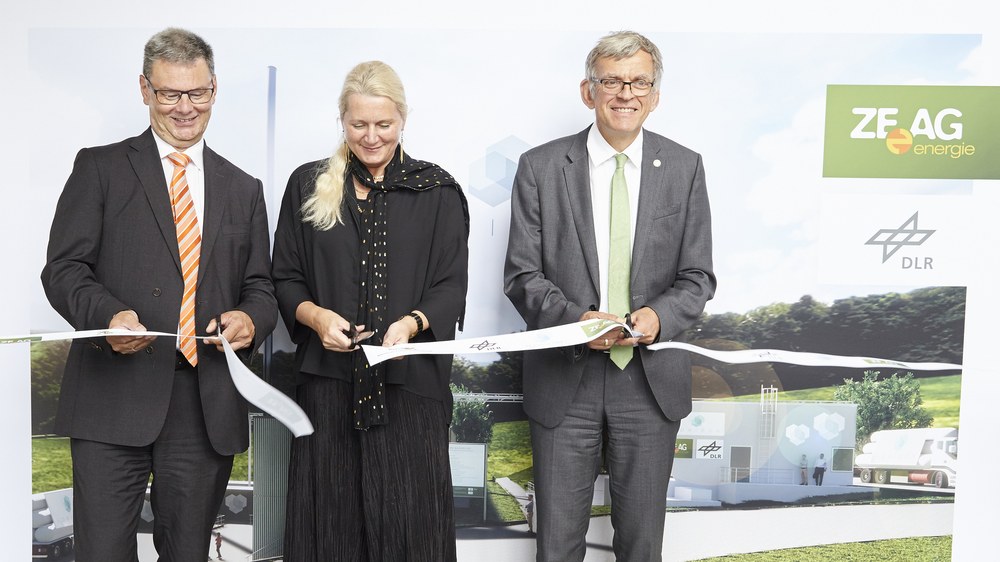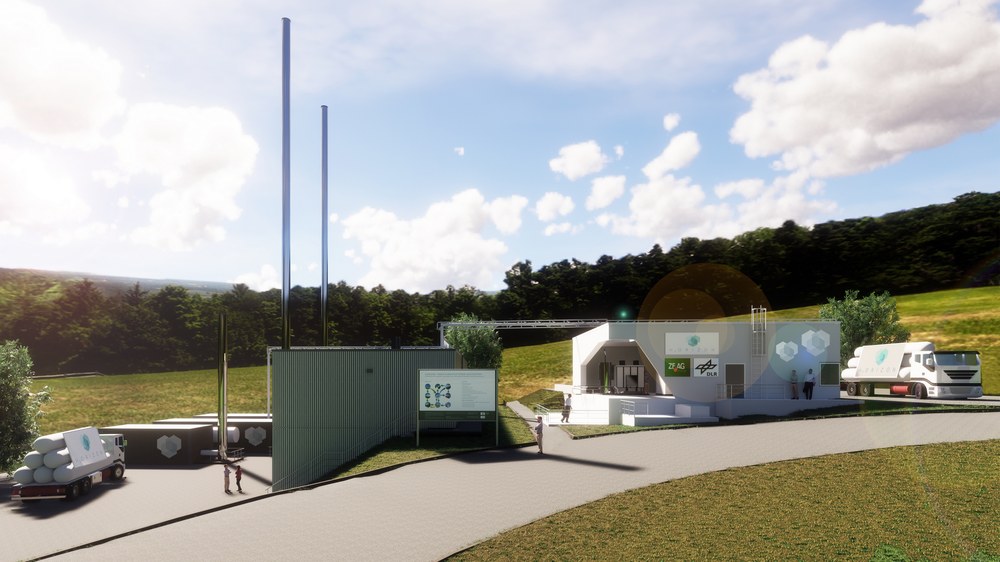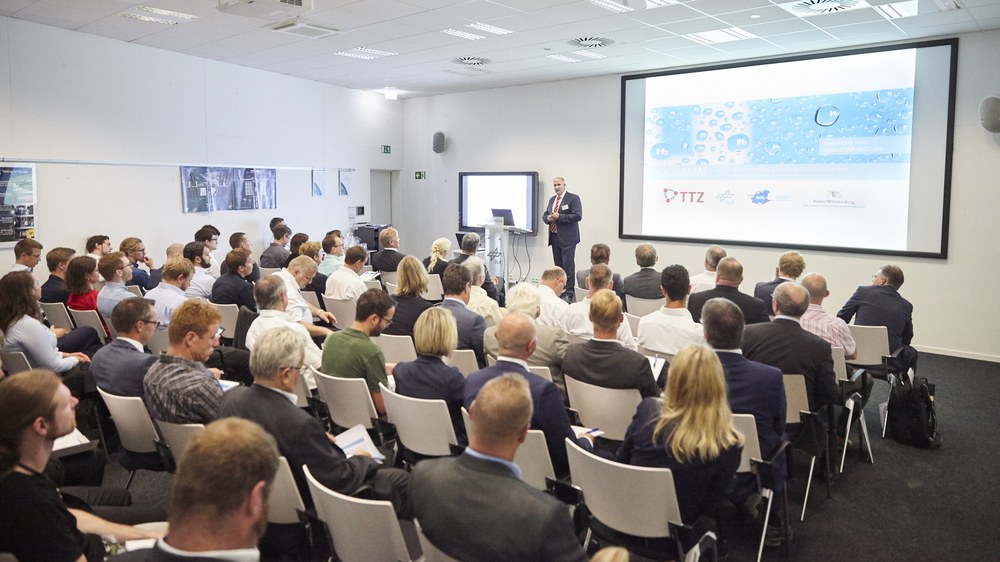H₂ORIZON – a new facility for renewable hydrogen production



- H2ORIZON is a research and demonstration facility in Lampoldshausen that produces hydrogen from wind energy and also supports energy supply for the DLR site.
- H2ORIZON was officially opened on 5 July 2018, with around 90 policymakers, industry representatives and researchers in attendance.
- The project demonstrates the sector coupling of space, energy and transport on a megawatt scale.
- Focus: Energy, technology transfer, space
A key component of the future energy sector is currently in development at the Lampoldshausen site of the German Aerospace Center (Deutsches Zentrum für Luft- und Raumfahrt; DLR), 50 kilometres north of Stuttgart. DLR and industry partner ZEAG Energie AG from Heilbronn have combined their technology and systems expertise to establish a new a hydrogen-based networked energy system. This interdisciplinary research platform aims to advance hydrogen technology and provide new technologies for sector coupling processes. Pascale Ehrenfreund, Chair of the DLR Executive Board, and Eckhard Veil, Chairman of ZEAG Energie AG, officially inaugurated the H2ORIZON research and demonstration platform, which is nearing completion, on the sixth Hydrogen Day at DLR Lampoldshausen on 5 July 2018, alongside Helmfried Meinel, Head of Department at the Baden-Württemberg Ministry of the Environment, Climate Protection and Energy. "Tomorrow’s sustainable energy supply will be flexible, decentralised and connected. We share this vision with our partner, ZEAG Energie AG," said Pascale Ehrenfreund at the inauguration.
H2ORIZON – sustainable solutions for the challenges of future energy supply
Lampoldshausen is home to one of the largest hydrogen users in Europe – the DLR Institute of Space Propulsion. It is also located near to the largest wind farm in Baden-Württemberg. The DLR Institute of Space Propulsion and ZEAG Energie AG are taking advantage of the proximity of these two facilities by constructing a test centre for the renewable production of hydrogen in Lampoldshausen. There, researchers will explore ways to gradually decarbonise the energy and transport sectors and open up new possibilities for energy supply. "With H2ORIZON, DLR and ZEAG are addressing the global challenges presented by the need for a sustainable, secure and affordable future energy supply. Synergies within DLR across the research fields of energy, transport and space, as well as with industry, will be harnessed through this project. H2ORIZON bridges the gap between the generation of knowledge and its application on an industrial scale for the benefit of society and the preservation of our way of life," Pascale Ehrenfreund explained to the approximately 90 invited representatives from politics, industry and research.
"By embarking on this joint project, DLR and ZEAG have taken a bold step towards the future," said Meinel. The task now is to identify suitable applications for the use of the generated hydrogen. "I am very confident that we will achieve this. As a chemical source of energy, hydrogen is used for long-term storage in the electricity and heat sector, in the mobility sector and in the chemical industry. As such, it is highly important for the increasingly sector-coupled energy system of the future." Meinel went on to stress that H2ORIZON is key to the implementation of new hydrogen technology: "That is why we have been delighted to provide funding of 842,000 euro to the project over the past few years."
DLR Lampoldshausen combines successful core space focus with energy research for the future
Around two and a half years ago, DLR made the decision to bring together research expertise in hydrogen technology and sector coupling activities at one location. Since then, the project team has been working on the construction of a facility measuring 2000 square metres, in which technological and systemic solutions related to hydrogen will be researched and validated from autumn of this year. The suitable infrastructure of the DLR Lampoldshausen site, the unique synergy offered within DLR, the direct connection to the Harthäuser Wald Wind Farm and the cooperation with industry partner ZEAG Energie AG were all decisive factors that led to the selection of this location. "At DLR in Lampoldshausen we are developing the sector coupling technologies of tomorrow on an industrial scale," says Eckard Veil, CEO of ZEAG Energie AG. "In doing so, we are demonstrating a unique facility for combining electricity production that fluctuates depending on the weather, such as wind or solar power, and the conversion of this energy into hydrogen. This hydrogen will be a key source of energy that can then be used for fuel cell vehicles, supplying heat to the site, or by DLR’s test stands."
H2ORIZON: background information
The H2ORIZON project’s overall concept consists of two essential components. One is renewable hydrogen production using electricity generated by harnessing the wind. The system uses polymer electrolyte membrane (PEM) electrolysis, which has an installed power of approximately one megawatt and is connected directly to the Harthäuser Wald Wind Farm. The produced hydrogen is processed, compressed and filled directly into special transport vehicles, known as tube trailers, for distribution. The second component is the new system to supply the DLR site with heat and electricity. Two combined heat and power plants (CHPs) powered by gas engines with a total thermal output of 1.6 megawatts and electrical output of 1.4 megawatts are connected directly to the hydrogen generation system and with a conventional supply of natural gas. "We are proud to be able to plan and now implement such a connected energy system. The whole team has been working intensively on this for a number of years. Everyone is looking forward to the first tonne of hydrogen, which we expect to produce in November 2018," says Claus Flore, project lead for H2ORIZON. In the future, the facility will be able to produce up to 100 tonnes of hydrogen per year.
Hydrogen – the key to reduced emissions
Hydrogen Day, which was held for the sixth time at the DLR in Lampoldshausen to mark the inauguration, focuses on the intelligent networking of the heat, electricity, gas and transport sectors and the role of hydrogen as a renewable source of energy. "Energy systems are facing transformation on an unprecedented scale. Ideas such as the sustainability, networking and security of supply, as well as decentralised and secure infrastructure, are all set to shape the robust and environmentally friendly energy supply of the future," said Stefan Schlechtriem, Director of the DLR Institute of Space Propulsion, in his welcoming address. The diverse aspects of sector coupling will be the subject of cross-disciplinary discussion. Hydrogen Day is held in strategic partnership with the Heilbronn-Franken Economic Development Agency and the Technology Transfer Centre (TTZ).
